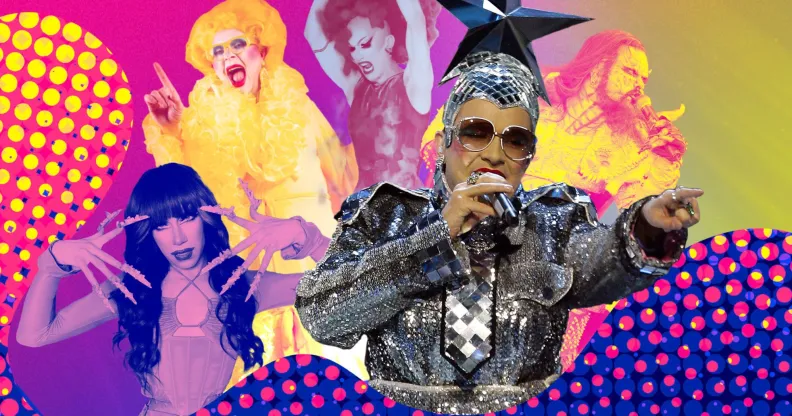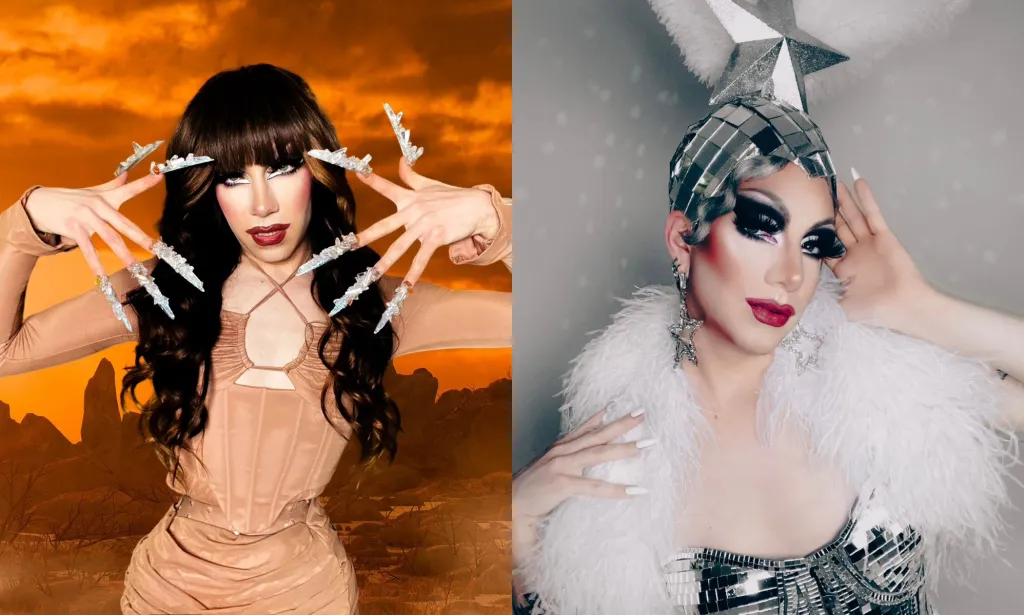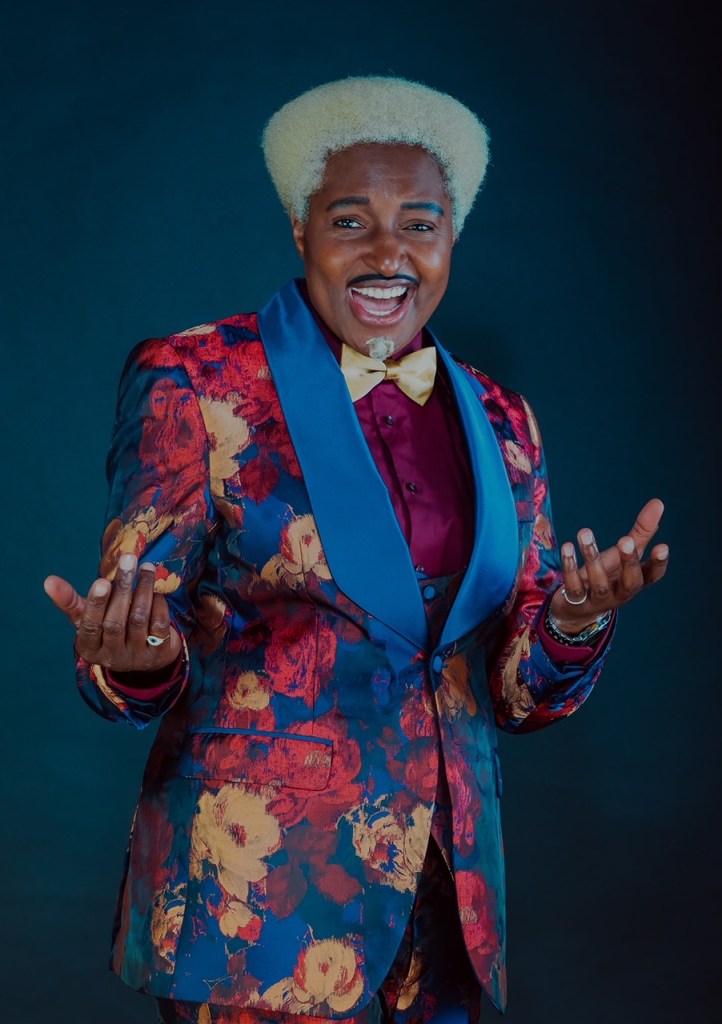From Verka Serduchka to Sasha Velour: How Eurovision and drag culture became one and the same

The line between Eurovision and drag culture has become joyously blurred. (Eurovision/Supplied/Eurocamp/World of Wonder/ PinkNews)
When Ginny Lemon auditioned for The X Factor in 2017 with Liberty X’s “Just A Little”, judge Louis Walsh had a thought. Had Ginny ever considered performing Verka Serduchka’s Eurovision tune “Dancing Lasha Tumbai” instead?
“Ever since I went away from that I’ve sang Lasha Tumbai at every show I’ve ever done, so it was sage advice from The X Factor panel there,” Ginny says now. “Doesn’t work so well with a thick West Midlands accent though.”
When you think about the intersection between drag and the Eurovision Song Contest, Ukraine’s Verka Serduchka is the first act many will think of. The comedian and drag entertainer rocked the competition back in 2007, with their inimitable space disco get-up and an infuriatingly catchy song to boot, storming their way to second place.
Eurovision’s open-arms approach to drag extends far beyond Verka though, from Norway’s 1986 act Ketil Stokkan featuring drag queens during their performance, to drag trio Sestre who represented Slovenia in 2002, and, of course, Conchita Wurst’s big win in 2014. Yet, while the existence of drag performers on the Eurovision stage is an obvious crossroads between the two pop culture monoliths, much more can arguably be said about how the contest as an entity has influenced drag in general.
“One of the biggest drag influences that I’ve had from Eurovision is that heavy metal band, Lordi,” Ginny Lemon says. The Finnish group won the contest in 2006 with the grungy “Hard Rock Hallelujah”, but it was their aesthetic that truly set them apart. Decked out in full monster costumes, complete with prosthetics, weapons, and automated wings, Lordi’s performance was more than just that; it was a brand identity.
“Lordi – their costumes are insane,” says 24-year-old Eurovision vlogger and drag artist Maxxy Rainbow. “Mr Lordi is the frontman of the group and he makes all those prosthetics and costumes. That’s so drag, being able to do all those things yourself – be the musician, be the artist, be the singer, and be the costume designer. That is drag, 100 per cent.”
Born in the US, Maxxy only caught wind of the Eurovision hype in 2016, after stumbling on 2010’s winning entrant, Germany’s Lena with “Satellite”. That year, she watched the contest live, immediately falling in love with Ukraine’s Jamala and her eventual winning single, “1944”.
Having started in 2013, Maxxy was still relatively new to drag when she discovered the contest. “I was starting to venture out into costuming and outfits, and I remember I got super influenced by Jamala in all these different ways,” she explains. “She always wore pants because it made her feel strong, it made her feel like she could really let go. I only wore pants in my drag career for like three years because of her.”
From there, Maxxy moved onto Eurovision cosplays, dragging herself up as whichever artist was her favourite from each year. “Eurovision has always kind of been inspiring my drag since I started,” she says. “It’s just kind of evolved over time.”
Acts like Lordi, or 2022’s wolf-headed duo Subwoolfer, or this year’s Let 3, exemplify the connection between Eurovision and drag culture, Maxxy feels. “These people that put on these characters, they have a fully-realised vision and story, and it goes so beyond just music. It’s an entire created universe.”

She draws comparisons between the way Eurovision acts attempt to inject exactly who they are into a three-minute performance to the way drag performers might craft a brand through the lip-syncs they do, or the outfits they bring for a stint on RuPaul’s Drag Race. “The drag that I love is drag where everything goes together, from the song choice, to the outfit, to the make-up, to the way that they perform. All these things go together.”
Sometimes, an attempt at pulling together a brand might veer towards the gimmicky. Where drag and Eurovision are concerned though, that’s all part of the fun.
“I’m called Ginny Lemon, for f**k sake. Fancy a slice! I love a gimmick and everything like that,” Ginny says. “What I always say is that I take being a joke very seriously, you know, and I think that’s what the Eurovision Song Contest does.”
They use Loreen as an example. For “Euphoria”, which Ginny believes could be the “best Eurovision song of all time,” the Swedish singer used her dress billowing behind her to catch the audience’s eye. For her 2023 return, she’s using her talon-like nails and sandwiched staging. It’s an identity signifier, much like drag performers and their famous taglines or signature looks. “It’s still camp, it’s still drama, it’s still theatrical,” Ginny says of Loreen’s performances. “It’s still drag, in a way.”
Maxxy agrees that Eurovision legends and drag icons are one and the same when it comes to trying to pull off new and exciting stunts and tricks to get the audience in their corner.
“We think of Sasha Velour and the rose petals, something like that that just grabs your attention and has never been done before,” Maxxy says. “I’m thinking of Eurovision performances that have had those kinds of moments, [with] something that we never saw before. If you go really far back, I think it was Bucks Fizz [in 1981] that does the tearaway clothing, and that’s like, so drag.” It only takes three phone calls with drag performers to find a queen who has a Bucks Fizz tearaway planned as part of their routine during this year’s Eurovision week.
As drag has enveloped the mainstream, the lines between drag and Eurovision culture have become increasingly, joyously blurred. Earlier this year, Loreen starred as a guest judge on the first season of Drag Race Sverige, and watched two queens tackle a “Euphoria” lip-sync.
During Ginny Lemon’s season of Drag Race UK, the challenge the week after she left the competition was ‘The RuRuvision Song Contest’, one of the best-rated episodes in the franchise’s history. In 2019, a petition was started to get Drag Race UK girl group The Frock Destroyers to represent the UK at Eurovision; almost four years on, it still gains signatures today.
“I think Eurovision has influenced drag in a wider sense, but I also think drag has influenced Eurovision,” says drag king Don One. Earlier this week, they performed at drag event ‘EuroCamp presents… The Best and The Wurst of Eurovision’ in Liverpool, rolling out a string of camp classics like Gina G’s 1996 ear-worm “Ooh Aah… Just a Little Bit”.

“Drag represents being an exaggerated form of your character, or even just being completely different to who you are,” Don says. “Some of the acts that you see at Eurovision really bring that over the top level of performance that you wouldn’t see on a normal stage.”
However, Don stresses that while Eurovision welcomes drag queens and drag creatures, there’s always been a bit of a dearth of drag king performers in the contest.
“I think that is indicative of life in general, because society doesn’t give the same visual representation to drag kings as it does to drag queens, which is really sad, actually,” Don says. “It really feels like it’s time for Eurovision to have drag kings involved. So that’s what I would like to see in the future.”
It makes more sense, then, to see drag and Eurovision as naturally entwined, rather than one determining the other.
Looking at the way the UK appears to be falling back in love with Eurovision, and how drag is increasingly conquering the entertainment world, it’s not a stretch to think a drag king, queen, or thing could represent us in the very near future.
“Drag has become a subculture into now popular culture, so everyone fancies a slice,” Ginny rounds off. “We’re seeing drag on daytime TV, we’re seeing drag on Eurovision.
“It’s high time that drag got the respect that it deserves and the appreciation. Because as a drag culture, we’re now on that huge, multinational world stage. We’re influencing.”

